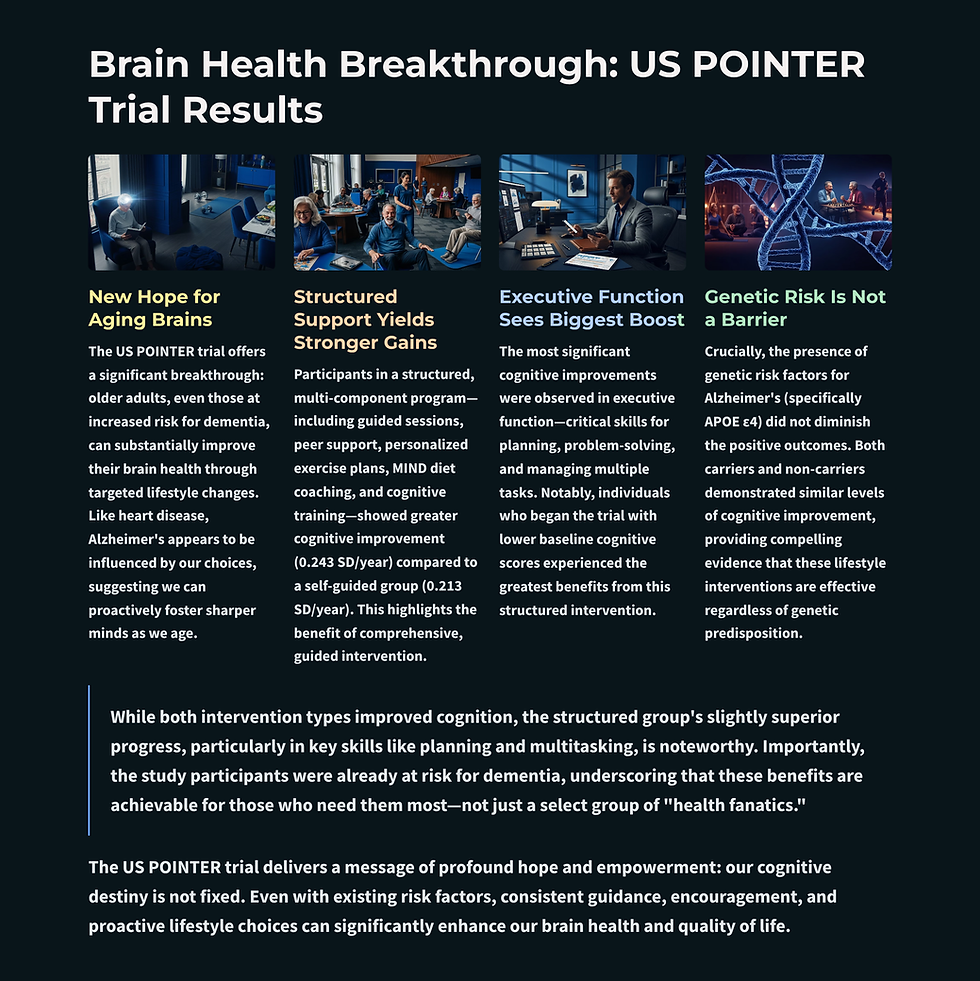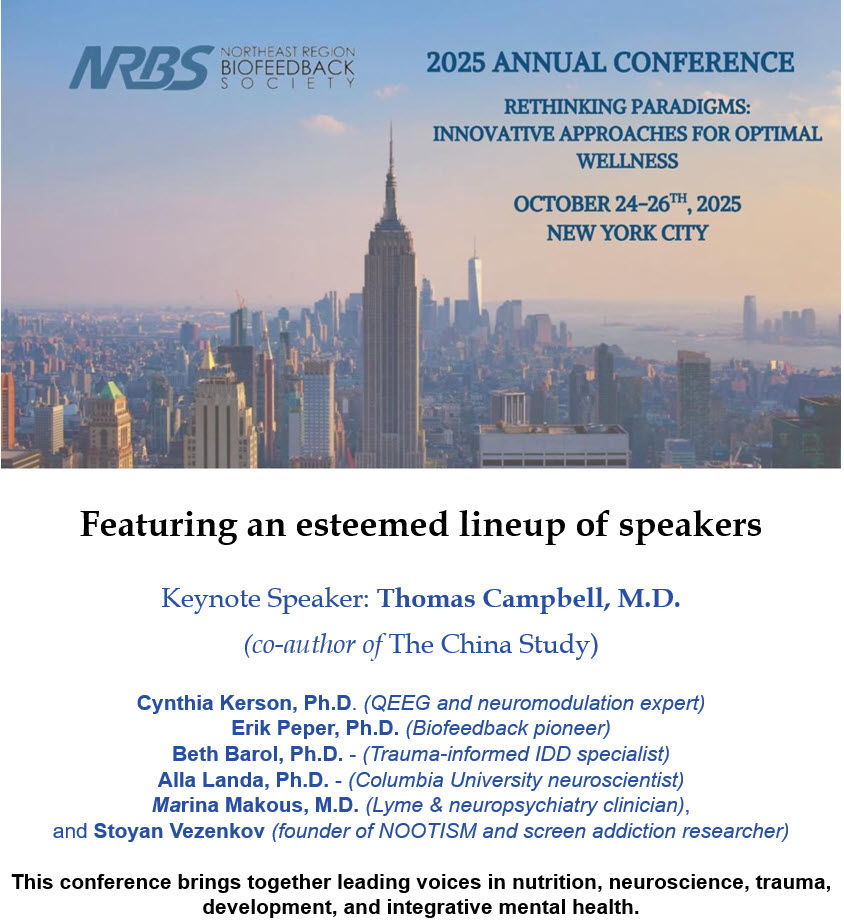5-Minute Science: Alzheimer's Risks Can Be Reduced by Lifestyle Changes
- Fred Shaffer
- Jul 30
- 6 min read
Updated: Aug 24

Takeaway
The US POINTER trial reveals that older adults can boost their brain health through targeted, structured lifestyle changes.
While both structured and self-guided approaches improved cognition, the structured group experienced slightly more progress, particularly in skills like planning and multitasking. Importantly, this was a group of people already at risk for dementia—not elite athletes or health fanatics.
Like heart disease, Alzheimer’s isn’t inevitable—targeted lifestyle changes can significantly reduce the risk.
The takeaway is both hopeful and empowering: even when risk factors stack up, our brains are not doomed to decline. With enough guidance, encouragement, and consistency, we can age into sharper minds.
What is the science?
Behind this study is a powerful scientific premise: many forms of cognitive decline are driven by modifiable risk factors. Unlike the unchangeable roll of genetic dice, habits like physical activity, diet, and cognitive engagement can be reshaped. In fact, the US POINTER trial took inspiration from earlier findings in Finland, where a similar multidomain lifestyle program slowed mental decline in at-risk older adults. This trial set out to test whether that success could translate to a more diverse American population, using tools and community resources that everyday people could actually access.
The theory is simple: tackle multiple threats to brain health—sedentary behavior, poor diet, social isolation, cardiovascular risk—and you’ll slow or even reverse the slide toward cognitive impairment.
What did they study?
The study enrolled over two thousand participants aged 60 to 79 who weren’t yet showing signs of dementia but who had lifestyles and health profiles that put them on a concerning path.
These individuals were physically inactive, ate poorly, and had at least two additional risk flags like high blood pressure, cholesterol problems, a family history of memory loss, or belonging to a racially or ethnically minoritized group.
All participants were screened to ensure they were cognitively healthy at the start, which made it possible to measure gains rather than just slowing losses. Researchers wanted to know: can two different styles of lifestyle coaching—one with hands-on structure, the other more hands-off and self-paced—actually change cognitive trajectories?
How did they do it?
Participants were randomly assigned to one of two groups. The structured group had regular, guided sessions featuring peer support, exercise plans, MIND diet coaching, cognitive training software, and check-ins to review things like blood pressure and lab results. They were nudged, monitored, and encouraged along the way—kind of like having a brain-health personal trainer. The self-guided group received printed resources, less frequent contact, and more freedom to go at their own pace.
Both groups were followed for 2 years, with memory, attention, and processing speed tested every 6 months using a composite score derived from standard neuropsychological assessments. The result was a detailed timeline of how their brains performed—and evolved—over time.
What did they find?
Brains in both groups showed signs of improvement, but the structured group came out slightly ahead.
They gained 0.243 standard deviations per year on the composite cognitive score, compared to 0.213 in the self-guided group—a statistically significant edge. The biggest differences were in executive function: skills needed for managing tasks, juggling information, and making decisions.
Episodic memory gains were similar across groups, suggesting that structure especially helps with complex mental coordination. People who started the trial with lower cognitive scores benefited the most from structure.
Interestingly, the presence of a genetic risk factor for Alzheimer’s didn’t change the outcome—both APOE ε4 carriers and non-carriers responded similarly. The intervention was also well-tolerated, with slightly fewer serious adverse events in the structured group.
What were the strengths and limitations?
One of the defining strengths of the US POINTER trial is its rigorous design. As a large, multicenter, randomized clinical trial, it minimized bias and ensured that the results could be attributed to the interventions rather than chance or confounding variables. The study also succeeded in enrolling a demographically diverse cohort—both in terms of race and ethnicity and cardiometabolic risk factors—helping to address a long-standing gap in brain health research. This diversity increases the relevance of the findings across broad segments of the U.S. population, especially among communities historically underrepresented in dementia prevention studies.
Another major strength was the high retention and adherence rate. More than 89% of participants completed the final assessment, and attendance at peer meetings exceeded 90% in both arms of the trial. This level of engagement underscores the feasibility of implementing similar interventions in community settings. The use of a validated composite score to capture subtle cognitive changes added both sensitivity and statistical power to the outcome measurements, while the frequent follow-ups enabled a detailed trajectory of cognitive performance over time.
Yet the study is not without its limitations.
While both groups improved, the lack of a true no-intervention control means it's difficult to determine how much of that improvement was due to the interventions themselves versus general effects of study participation, such as placebo responses or repeated testing. The structured group, for instance, had far more contact with staff, which could have increased motivation, reporting, or even inadvertently introduced bias.
Additionally, because participants had to commit to a two-year study with regular visits and self-monitoring, they may not fully represent the most vulnerable older adults—those with limited access, frailty, or less motivation—limiting the real-world generalizability. The cognitive gains, while statistically significant, were modest in size, and their practical importance remains unclear until longer-term outcomes, such as functional independence or dementia incidence, are evaluated.
Furthermore, the trial was not powered to assess progression to clinical impairment or dementia, so its findings are best understood as preventive rather than therapeutic. Finally, the open-label design—participants knew which group they were in—leaves room for expectancy effects, although these were mitigated by rigorous blinding of outcome assessors.
Despite these caveats, the trial offers compelling evidence that how we live shapes how we age, especially when supported by structure and community.
What is the impact on treating Alzheimer's?
This trial makes a persuasive case for taking brain health into our own hands—ideally with some expert guidance. It suggests that structured support doesn’t just improve motivation but enhances results, especially for people most vulnerable to cognitive decline.
The findings hint at the possibility of delaying or softening dementia’s arrival using accessible, everyday tools—exercise routines, healthy food, mental workouts, and blood pressure checks.
There’s still more to learn: are these benefits durable? Do they extend to real-world functioning and independence? But for now, US POINTER points clearly in one direction: toward hope, agency, and the possibility that how we live can shape how we think—well into our later years.
Key Takeaways
A structured, high-support lifestyle program led to greater cognitive gains than a low-support, self-guided approach.
Executive function improved most in the structured group, especially among those starting with lower cognitive scores.
Cognitive benefits were consistent across age, sex, and APOE ε4 status, suggesting broad applicability.
High adherence rates in both groups support the real-world feasibility of lifestyle-based brain health interventions.
Structured lifestyle change is a safe, practical, and promising strategy for reducing dementia risk without drugs.

Glossary
APOE ε4: a genetic variant associated with a higher risk of developing Alzheimer’s disease.
cognitive composite score: a combined score reflecting performance in memory, executive function, and processing speed, used to track changes over time.
executive function: mental processes that include working memory, flexible thinking, and self-control—essential for planning and decision-making.
MIND Diet: a brain-healthy diet combining elements of the Mediterranean and DASH diets, designed to reduce cognitive decline.
Multidomain Lifestyle Intervention: a coordinated approach that simultaneously targets several risk factors, such as physical inactivity, diet, and social isolation.
neuropsychological test battery: a standardized set of assessments used to measure various aspects of cognitive functioning.
processing speed: the pace at which someone can take in, understand, and respond to information.
standard deviation (SD): a statistical measure that quantifies how much a score deviates from the average, often used to interpret cognitive change.
structured intervention: a lifestyle program that includes scheduled activities, coaching, peer support, and regular monitoring.
self-guided intervention: a more flexible lifestyle program with minimal oversight, where participants manage their own behavior change.
About the Author

Fred Shaffer earned his PhD in Psychology from Oklahoma State University. He earned BCIA certifications in Biofeedback and HRV Biofeedback. Fred is an Allen Fellow and Professor of Psychology at Truman State University, where has has taught for 50 years. He is a Biological Psychologist who consults and lectures in heart rate variability biofeedback, Physiological Psychology, and Psychopharmacology. Fred helped to edit Evidence-Based Practice in Biofeedback and Neurofeedback (3rd and 4th eds.) and helped to maintain BCIA's certification programs.
Support Our Friends










Comments